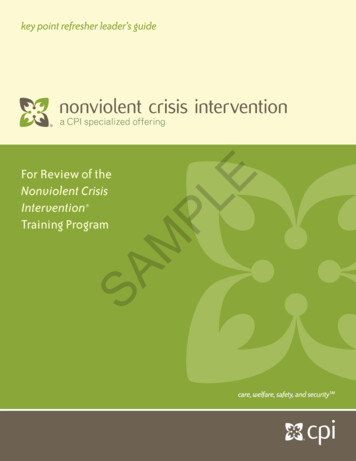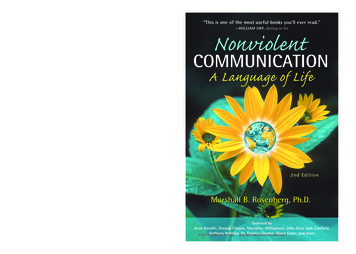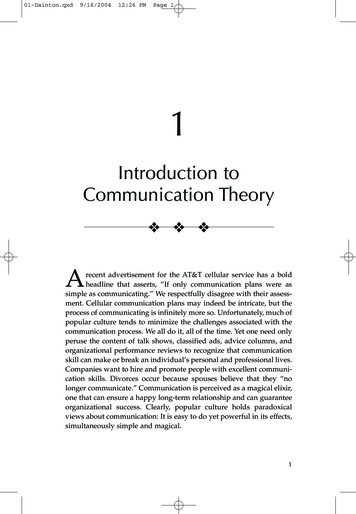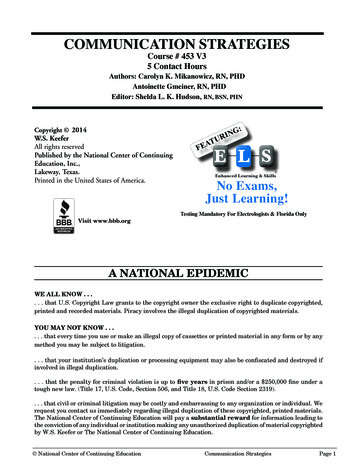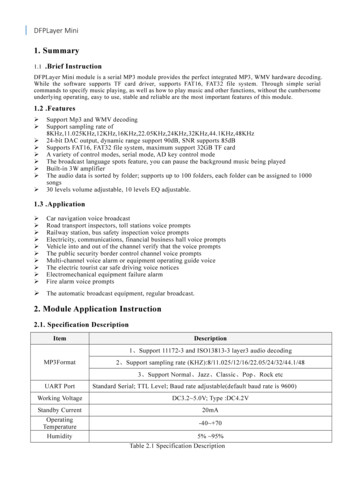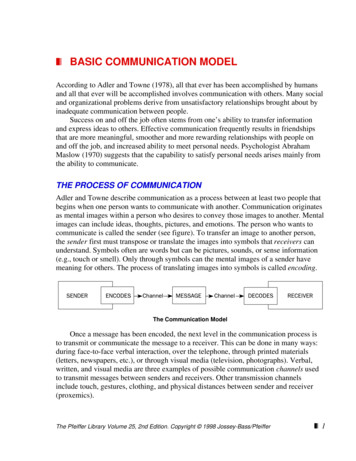
Transcription
Introduction to Nonviolent CommunicationMarcia ChristenCertified Trainer with the Center for Nonviolent CommunicationCompassionate Languagecreating peace & understanding within ourselves & with each onate-language.comcellphone: 360. 509 .3586Marcia ChristenCertified Trainer with The Center for Nonviolent Communicationmarcia@compassionate-language.com
Nonviolent CommunicationNonviolent Communication (NVC) is a process to prioritize connection.The purpose is to create a quality of connection where all needs are valued with fullcare and needs are met by natural giving and receiving.Living NVC in relating to others involves: The intention to connect mutually in dialogue, to see the humanness in the other,and to authentically reveal one's own humanness. This intention and connection results in mutually valuing each other's needs andenjoying giving to one another.ELEMENTS OF NVCThinkingConsciousnessLanguage- Interdependence- Natural giving- Power withCommunicationUse ofPowerMarcia ChristenCertified Trainer with the Center for Nonviolent nguage.com
KEY ASSUMPTIONS of NVCAssumptions Underlying Nonviolent CommunicationUniversality of Human Needs:We all have the same needs. Where we differ from each other is in our strategies to connect/meet needs.Conflicts occur at the level of strategies, not needs.Needs and Feelings:Feelings result from the recognition and attention to needs or not: Our feelings are directly related to ourneeds. When our needs are recognized and attended to, we feel happy, satisfied, excited, etc. When ourneeds are not recognized and attended to, we feel sad, scared, angry, etc. (These are the words of ElanaSabajon)Actions Result from Needs:Our actions are motivated by a desire to connect to needs. We would prefer to meet needs in ways that don’tharm others if we recognize a path of action that will also meet our own needs. Even when we resort toviolence, we are still attempting to meet needs, however tragically.Natural Giving:It is deeply inherent in the nature of human beings that we enjoy, contributing to others, and will do so if wecan trust that we can choose not to contribute without suffering consequences.Sufficiency:Though in individual situations it appears that there isn’t enough to meet everyone’s needs, there is noinherent scarcity for meeting everyone’s basic needs; through dialogue and connection we can meet morepeople’s needs more peacefully.Marcia ChristenCertified Trainer with the Center for Nonviolent nguage.com
KEY PRINCIPLES of NVCKey Principles of Nonviolent CommunicationWe choose to act in line with the following principles because we believe that using this approach we aremore likely to contribute to a world where everyone’s needs are attended to peacefully.Responsibility for Our Feelings:We aim to move away from blaming ourselves or others for our feelings, by connecting our feelings toour own needs. This recognition empowers us to take action to meet our needs instead of waiting forothers to change.Responsibility for Our Actions:We aim to recognize our choice in each moment, and take action based on seeing how it would meetour needs to do so; we aim to move away from taking action based on fear, guilt, shame, the desire forreward, or any “should” or “have to”.Prioritizing Connection:We aim to focus on connection instead of immediate solutions, and to trust that connecting with ourown and others’ needs is more likely to lead to creating solutions that meet everyone’s needs.Equal Care for Everyoneʼs Needs:We aim to make requests and not demands; when hearing a “No” to our request, or when saying “No”to another’s request, we aim to work towards solutions that meet everyone’s needs, not just our own,and not just the other person’s.Self-Expression:When expressing ourselves, we aim to speak from the heart, expressing our feelings and needs, andmaking specific, do-able requests rather than demands.Empathic Hearing:When we hear others, we aim to hear the feelings and needs behind their expressions, even whenthey express judgments or demands.Protective Use of Force:We aim to use force only to protect, not to punish others or get our way without the other’s agreement, and only in situations where the principles above were not sufficient to meet immediate needsfor safety. We aim to return to dialogue as soon as safety is re-established.Marcia ChristenCertified Trainer with the Center for Nonviolent nguage.com
WORDS USED TO EXPRESS FEELINGSThese words refer to my own internal experience rather than external circumstancesFEELINGS WHEN NEEDS ARE NOT DissatisfiedGrief strickenHeartbrokenHurtMoroseFull of itantInsecureJitteryLeeryMistrustingNervousOn FEELINGS WHEN NEEDS ARE ntOverjoyedRadiantSplendidTickledMarcia ResistantTicked vingOpen heartedCertified Trainer for The Center for Nonviolent ionate-language.com
THOUGHT FEELINGSfeelings mixed with evaluationsabandonedabused eddistrusteddumped intimidatedisolatedinvalidatedinvisibleleft rworkedpatronizedpressuredput downrejectedripped offWhen one of these words comes to mind, look behind it to ask, “when I think I am , whatam I feeling? ” Then express the feeling behind the thought. IE “ When I think I am neglected,I feel lonely, sad, or worried.Non - Feeling ExpressionsFeeling are not likely expressed after these phrases. Thoughts, evaluations, judgments and criticismsusually follow these phrases.I feel like I feel it .I feel you Marcia ChristenI feel that I feel as if I feel (he she they) Certified Trainer for The Center for Nonviolent e-language.com
UNIVERSAL HUMAN NEEDSThis list builds on Marshall Rosenberg’s original needs list with categories adapted for Manfred Max Neef.Note: This list is provided only as a tool for study. No list is an substitute for each one of us finding our truth using our own wordsthat fit our experience.SubsistencePhysical hysical SafetyTouchWaterConsistencyOrder/StructurePeace (external)Peace of MindProtectionSafety rcia ChristenTo MatterUnderstandingCommunityLeisure/ RelaxationConnectionIntegritySelf acceptanceSelf careSelf connectionSelf knowledgeSelf realizationSense of selfMattering to tual recognitionRespectTo be heardTo be knownTo be seenTo be trustedTo be understoodUnderstanding onyIntimacyLoveNurturingSexual ationPartnershipSelf tivityDignityGrowthHealingHonestyCertified Trainer with The Center for Nonviolent arityDiscoveryLearningMake sense of munionFaithFlowHopeInspirationMourningPeace m
COLLOQUIAL EXPRESSION OF NEEDSThe phrases below are some suggestions for how you can expand the range of options available to you forexpressing your needs and for guessing those of other (instead of always using the word need) On thedotted live you can insert any word for the needs inventory on the previous page. All of these phrases can beused as long as the consciousness we bring to them is that of needs. Otherwise we run the risk of blurringthe distinction between needs and strategies.You love You thrive on You really enjoy You would be nourished by .You value You want You long for is fun for you. matters to you/ is meaningful to you makes your life worthwhile helps you feel well/whole/good/happy is so important to youSample Connection RequestsThe following are some possible ways of phrasing common connection requests during a dialogue.Request to support the quality of connection1.2.3.4.5.Would you tell me what you just heard me say?Would you tell me your understanding of my needs and feelings?Would you be willing to listen to me talk about my experience?Would you tell me how you're feeling about what I just said?Would you tell me specifically what I can do that would help youfeel more confident that I understand what you're saying?Requests to support connection towards solution1.2.3.4.5.6.Would you tell me what you need to know in order to agree to my request?Would you tell me what needs of yours are preventing you from saying yes to my request?Would you tell me what you're hearing in my expression that’s leading you to say no to my request?Would you brainstorm together to come up with solutions that would work for both of us?Would you tell me if there is any way for us to work this out other than agreeing to your request?Would you tell me if you imagine any other strategies that would meet both our needs?Marcia ChristenCertified Trainer with the Center for Nonviolent nguage.com
NONVIOLENT COMMUNICATION(NVC)NVC is a learnable process designed to reliably increase well beingIt involves:2 framesEngaging with an intention to establish a quality of connection that leads to everyone’sneeds being met peacefully and bringing attention to the present.3 ModesConnecting with myself, receiving others and expressing myself.4 IngredientsFocusing on observations, feelings, needs and uestsconnecting with myselfExpressingMyselfPRESENTCONNECTIONMarcia ChristenCertified Trainer for the Center for Nonviolent uage.com
SELF EMPATHYaka What weʼre bringing into the roomTHOUGHTSTouching our head and naming stories, judgements, interpretations and beliefswe’re holding.TAKE A DEEP BREATHFEELINGSTouching our heart and naming the present body sensations and emotions we feel.TAKE A DEEP BREATHNEEDSTouching our belly and naming the underlying needs being expressed through thethoughts and feelings.BREATHE AND CENTERREQUESTSWith hands open to receive, naming the request for action that arises out ofconnecting to the needs.Marcia ChristenCertified Trainer with The Center for Nonviolent e.com
EMPATHY is.“ Empathy is respectful understanding of what others are experiencing. Often, instead of offering empathy,we have a strong urge to give advice or reassurance and to explain our own position or feeling.Empathy however calls upon us to empty our mind and listen to others with our whole being.”Marshall Rosenberg Empathy is respectful understanding of what others are experiencing The key element of empathy is to be present to whatever the other person is experiencing Empathy is NOT either, claiming yourself by taking on the message or blaming and judging the other person In relating to others empathy occurs when we have successfully shed or put aside preconceivedideas and judgments about the other person In NVC no matter what words people use - we are listening for feelings and needs and what thisperson is requesting to enrich their life Behind intimidating messages are simply people appealing to us to meet their needsReceiving with EMPATHY what the other person is saying:Reflect the observation of the situation or what they're referring to.Guess their feelings.Guess the needs they're wanting to meetEventually you can guess a possible request that would meet their needs.Speaker: I’m sick and tired of my stupid friends.Listener: (Observation) So when you think about being with your friends today(Feeling) Are you feeling discouraged?(Need) Are you wanting to have some consideration of what you want to do?(Requests come once all the Needs and on the table)Marcia ChristenCertified Trainer with The Center for Nonviolent Communicationmarcia@compassionate-language.com
EMPATHY is NOT.Some Habitual Responses:Advising: “I think you should . . .”One-upping: “That’s nothing, wait’ll you hear what happened to me . . .”Educating: “This could turn into a positive experience for you if you just . . .”Consoling: “It wasn’t your fault, you did the best you could.”Story-telling: “That reminds me of the time. . .”Shutting down: “Cheer up–don’t feel so badly”Sympathizing: “Oh you poor thing.”Interrogating: “When did this begin? – what did you do?”Explaining: “I would have called you but. . .”Correcting: “That’s not how it happened . . .”Self-EmpathyWhy do it? It reconnects us to Life – our feelings and needs. It provides learning and awareness. It connects us to our vision and energy from which we choose to live. It allows us to connect with others. It empowers us to act (make requests) to meet our needs.Marcia ChristenCertified Trainer with The Center for Nonviolent Communicationmarcia@compassionate-language.com
THE NVC TREE of LIFEThree focus options for connectionCommunicatingwhat’s alive in meWhen I see/hear.I feel.because I need.Would you be willing to .Verbalconnecting with what’s alive in youWhen you see/ hear.Are you feeling.because you need.Would you like.PR SELFESSIONNon-VerbalEMPATHEXYSELF EMPATHYOpening My Heart To:me: JudgmentsHow am I feeling?What am I needing?you: JudgmentsCould s/he be feeling?Could s/he be needing?Which option do I want to choose next? Empathy? Self Expression?Marcia ChristenCertified Trainer with The Center for Nonviolent Communicationmarcia@compassionate-language.com
THREE OPTIONS FOR CONNECTIONWritten practice in conjunction with the Tree of Life ModelSTIMULUS:Someone says/doesSELF - CONNECTION:Include judgments and thoughts (if thats what comes up) to help you connect with your feelings and needsMYSELFI feelBecause I needWhat I would like to do next isOTHER:What could s/he be feelingWhat could s/he be needingSELF - EXPRESSIONWhen I see/hearI feelBecause I needWould you be willing toEMPATHYAre you feelingBecause you needIf /when you are ready for strategy, you might also includeWould you likeMarcia ChristenCertified Trainer with The Center for Nonviolent nguage.com
FINGER MAPINTENTIONThoughts and Evaluations of what I observeSELF EMPATHY(Conscious intention to connect with self)ObservationWhat Happened? ( facts only)FeelingHow am I feeling about it?NeedWhat do I need now?RequestWhat might be my present requestfor connection or action?EXPRESSING HONESTLY(Conscious intention to connect with other)RECEIVING EMPATHICALLY(Conscious intention to connect with other)When I Hear see, taste, touch smell orremember.When you hear see, taste, touchsmell or remember.I feel.Do you feel.because I NEED (value).because you NEED (value).Would you be willing to .Would you like: Tell me what you heard me say? Tell me how you feel hearing what I justsaid? Do.a specific concrete action ? me to tell you what I heard? (did I getit?0 me to tell you how I feel? me to (do).? (specific concrete action)CONNECTIONMarcia ChristenCertified Trainer with The Center for Nonviolent Communicationmarcia@compassionate-language.com
RESOURCESMarcia Christen -- Certified Trainer with the Center for Nonviolent compassionate-language.comHome: 360. 779. 7909Cell: 360. 509 .3586Northwest Compassionate Communicationwww.nwcompass.orgWebsite for NVC materialswww.nonviolentcommunication.comNVC AcademyCenter for Nonviolent Communicationwww.cnvc.org5600 San Francisco Rd NE Suite AAlbuquerque NM 87109phone: 505 244-4041fax: 505 247-0414www.nvcacademy.comBay Area Nonviolent Communication55 Santa Clara Avenue, Suite 203Oakland, CA 94610Tel: 510. 433. 0700Email: nvc@baynvc.orgWebsite: www.baynvc.orgMarcia ChristenCertified Trainer with The Center for Nonviolent Communicationmarcia@compassionate-language.com
Strategies for Immersingin Nonviolent CommunicationThere is a difference between learning NVC and embodying the ‘consciousness’ of NVC. We can learn aforeign language, but until we start quickly translating and thinking in that language we may feel awkwardand unnatural and it may not be effective.Immersion in NVC is a great strategy to build ease, confidence and competency in understandingourselves, expressing ourselves and listening to others.READ, LISTEN, WATCH: Make a daily practice of reading any resource materials on NVC. Check The Center forNonviolent Communication (CNVC) at www.cnvc.org. Check what’s available in the library.Sign up for daily or weekly inspirational e-mails from www.nvcacademy.org orwww.nonviolentcommunication.com. And www.compassionate-language.com(Marcia Christen)PRACTICE: Join a weekly Practice group or Empathy circle – either over the phone or in person. Thereare online groups and for local groups see www.nwcompass.org. Create these practices inyour own group.Find an empathy buddy! Make an appointment to meet once a week and listen to eachother for 15-30 mins. each (listening for feelings and needs). Or get empathy every day!Translate bumper stickers and everything you hear and see into needs!CONNECT: Give yourself the gift of Self-empathy whenever needed; at breakfast, lunch or dinner! Whenyou walk to class or get up in the morning. Check in with your feelings and needs. Whatneeds are met? What needs do you want more connection to?Practice the head, heart, gut hand movements several times during the day for self-empathy.Join an NVC on-line chat group at one of the websites listed above.Add observation of feelings and needs as part of a meditation practice.Practice the Beauty of the Need Meditation.Listen to guided meditations.EXERCISES: Do the exercises in the NVC workbooks – or do them with a buddy or group.Use the handouts to focus on one thing and practice for a week.JOURNALING:Judgment Translation Journal – during the day, briefly jot down any judgments you had or heard or anytriggering situations where your Needs were not met, then later when you have more time, translate thejudgments into feelings and needs.1Marcia ChristenCertified Trainer with The Center for Nonviolent Communicationmarcia@compassionate-language.com
(cont.) Then reflect upon what you could have said or done differently to be more in alignment with your NVCpractice, note any mourning or wish you have about that situation and note any requests you now have,either of yourself or of the other, an action or a connection request.Gratitude Journal – Each day, write about two NVC appreciations or celebrations - one for yourself and one forsomeone/something else in your life. This can inspire us in times of hopelessness or despair.LEARN: Take an NVC workshop series; www.nvcacademy.org and www.nwcompass have lists oftrainings, teleclasses, downloads of previous workshops and online groups. Locally: MarciaChristen, CNVC trainer, has workshops, classes, practice groups and one-on-one sessions. Alsolook up local practice groups at www.nwcompass.org or www.cnvc.org. Create your own practice group using the companion workbook to Nonviolent Communication:The Language of Life, by Marshall Rosenberg.Suggested reading list:Available online at cnvc.org, puddledancerpress.org or nonviolentcommunication.comor at the public library.Nonviolent Communication: A Language of Life, by Marshall Rosenberg.Nonviolent Communication: A Language of Life Workbook, by Lucy Leu.Peaceful Living: Daily Meditations for Living Love, Healing and Compassion, by Mary MacKenzie.Being Me Loving You, a booklet by Marshall RosenbergThe Surprising Purpose of Anger by Marshall RosenbergGetting Past the Pain Between Us, a booklet by Marshall Rosenberg.The No Fault Classroom by Sura Hart and Victoria Kindle Hodson (for educators).Radical Acceptance by Tara Brach.Calming Your Anxious Mind, by Jeffrey Brantley.2Marcia ChristenCertified Trainer with The Center for Nonviolent Communicationmarcia@compassionate-language.com
Surprised Interested Intrigued lnvigorated Optimistic Spellbound Trusting Vulnerable Warm These words refer to my own internal experience rather than external circumstances www.nvc.org Marcia Christen Certified Trainer f or The Center for Nonviolent
